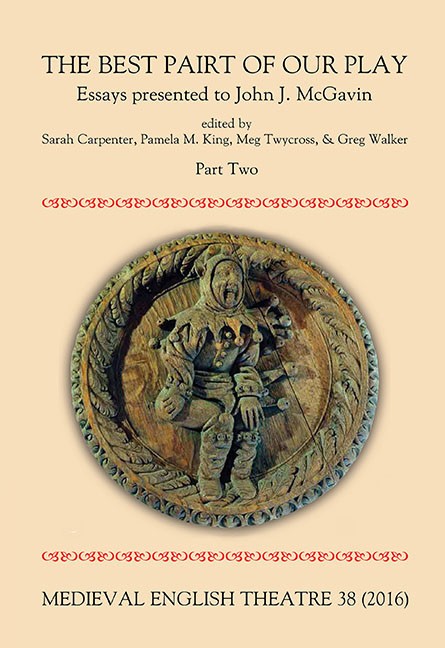 Medieval English Theatre 38
Medieval English Theatre 38 Book contents
- Frontmatter
- Contents
- Editorial
- The Funeral of Walter Scott, First Earl of Buccleuch: A Grand Ceremonial Occasion
- The Bright Star of the North: James I and his English Coronation
- ‘Ye know eek that in forme of speche is change’: Chaucer, Henryson, and the Welsh Troelus a Chresyd
- Playing the Crucifixion in Medieval Wales
- ‘My Boy shall Knowe Himself from Other Men’: Active Spectating, Annunciation, and the St John's College Narcissus
- ‘I Speke so Miche to Ȝow’: Authority, Didacticism, and Audience Address in Middle English Sermons and Morality Plays
- Early English Spectatorship and the ‘Cognitive Turn’
- The Theatre of the Mind in Late-Medieval England
- Poetics and Beyond: Noisy Bodies and Aural Variations in Medieval English Outdoor Performance
- Women and the Performance of Libel in Early-Modern
- Abraham Sacrifiant
- Miscellaneous Endmatter
Playing the Crucifixion in Medieval Wales
Published online by Cambridge University Press: 20 April 2017
- Frontmatter
- Contents
- Editorial
- The Funeral of Walter Scott, First Earl of Buccleuch: A Grand Ceremonial Occasion
- The Bright Star of the North: James I and his English Coronation
- ‘Ye know eek that in forme of speche is change’: Chaucer, Henryson, and the Welsh Troelus a Chresyd
- Playing the Crucifixion in Medieval Wales
- ‘My Boy shall Knowe Himself from Other Men’: Active Spectating, Annunciation, and the St John's College Narcissus
- ‘I Speke so Miche to Ȝow’: Authority, Didacticism, and Audience Address in Middle English Sermons and Morality Plays
- Early English Spectatorship and the ‘Cognitive Turn’
- The Theatre of the Mind in Late-Medieval England
- Poetics and Beyond: Noisy Bodies and Aural Variations in Medieval English Outdoor Performance
- Women and the Performance of Libel in Early-Modern
- Abraham Sacrifiant
- Miscellaneous Endmatter
Summary
When the formidable Adam Orleton was enthroned as Bishop of Hereford on 2 October 1317, he was still heavily involved in diplomatic negotiations for Edward II in London and in France, so his visits to his new see were brief and sporadic until late in the summer of 1320. At that point, perhaps in part due to his lengthy absence, perhaps in recognition of the less stringent administration on the part of his predecessor, Richard Swinfield, Orleton saw his first task as a widespread and substantial Visitation of the ecclesiastical establishments under his control. The importance of this initiative can be seen in his obtaining in January 1320 a bull from Pope John XXII authorising him to visit and correct the cathedral chapter, despite its traditional immunity from episcopal Visitation.
Among the establishments subject to Orleton's formal Visitation was the Benedictine Priory of St. Mary at Abergavenny, Monmouthshire. Events at the Priory had come to the attention of its local patron, John, second Baron Hastings, and had caused sufficient consternation that he had complained to the papal Curia. So, on Thursday, 25 September 1320, Orleton made a personal Visitation and recorded the results formally in his Register. He found that the Priory had not been subject to Visitation in the previous forty years, and that strict observance of the Benedictine Rule had seriously fallen off; that despite its income being sufficient to support thirteen monks, the Priory housed at most five or six; that no prior had been properly appointed by election, but that one Fulk Gastard had taken on the position of prior dative, and had himself been guilty of alienation of goods and ‘many vices of incontinent living’.
The monks were found to be neglecting the rule of silence, to be eating meat on fast days, to be neglecting the Night Offices, and to be playing forbidden games with dice and knuckle-bones.
- Type
- Chapter
- Information
- Medieval English Theatre 38The Best Pairt of our Play. Essays presented to John J. McGavin. Part II, pp. 57 - 67Publisher: Boydell & BrewerPrint publication year: 2017


